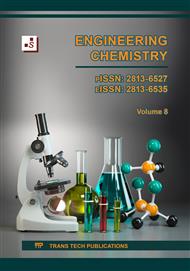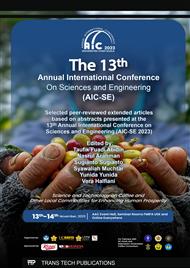[1]
A. Nilavazhagi and T. Felixkala, "Adsorptive removal of Fe(II) ions from water using carbon derived from thermal/chemical treatment of agricultural waste biomass: Application in groundwater contamination," Chemosphere, vol. 282, p.131060, 2021.
DOI: 10.1016/j.chemosphere.2021.131060
Google Scholar
[2]
P. B. Tchounwou, C. G. Yedjou, A. K. Patlolla, and D. J. Sutton, "Heavy metal toxicity and the environment," EXS, vol. 101. p.133–164, 2012.
DOI: 10.1007/978-3-7643-8340-4_6
Google Scholar
[3]
Li-Li Sui, H. Zhang, H. Ren, and H. B. Xu, "Adsorption of Fe(II) Ions from Aqueous Solution Using Silica-Supported Organic–Inorganic Hybrid Sorbents," Russian Journal of Physical Chemistry A, vol. 93, no. 5, p.936–945, May 2019.
DOI: 10.1134/S0036024419050303
Google Scholar
[4]
G. Thilagam, M. Hema, N. Mani, and S. Arivoi, "Adsorption behavior of Fe (II) ion from aqueous solution onto nano carbon," ~ 96 ~ International Journal of Chemical Studies, vol. 4, no. 1, 2016.
Google Scholar
[5]
A. Ahmad, A. Khatoon, S. H. Mohd-Setapar, R. Kumar, and M. Rafatullah, "Chemically oxidized pineapple fruit peel for the biosorption of heavy metals from aqueous solutions," Desalination Water Treat, vol. 57, no. 14, p.6432–6442, Mar. 2016.
DOI: 10.1080/19443994.2015.1005150
Google Scholar
[6]
H. Paudyal et al., "Synthesis, characterization and cation exchange performance of chemically modified pineapple waste biomass for the removal of Fe(II) from water," Results Chem, vol. 4, p.100608, 2022.
DOI: 10.1016/j.rechem.2022.100608
Google Scholar
[7]
X. Lin, Q. Xu, Y. Li, B. Zhao, L. Li, and Z. Qiang, "Modeling iron release from cast iron pipes in an urban water distribution system caused by source water switch," Journal of Environmental Sciences, vol. 110, p.73–83, 2021.
DOI: 10.1016/j.jes.2021.03.016
Google Scholar
[8]
G. C. Ghosh, M. J. H. Khan, T. K. Chakraborty, S. Zaman, A. H. M. E. Kabir, and H. Tanaka, "Human health risk assessment of elevated and variable iron and manganese intake with arsenic-safe groundwater in Jashore, Bangladesh," Sci Rep, vol. 10, no. 1, Dec. 2020.
DOI: 10.1038/s41598-020-62187-5
Google Scholar
[9]
J. Saleem, U. Bin Shahid, M. Hijab, H. Mackey, and G. McKay, "Production and applications of activated carbons as adsorbents from olive stones," Biomass Conversion and Biorefinery, vol.9, no. 4. Springer Verlag, p.775–802, Dec. 01, 2019.
DOI: 10.1007/s13399-019-00473-7
Google Scholar
[10]
W. Li et al., "Selective adsorption of heavy metal ions by different composite-modified semi-carbonized fibers," Sep Purif Technol, vol. 328, p.125022, 2024.
DOI: 10.1016/j.seppur.2023.125022
Google Scholar
[11]
E. K. Putra, R. Pranowo, J. Sunarso, N. Indraswati, and S. Ismadji, "Performance of activated carbon and bentonite for adsorption of amoxicillin from wastewater: Mechanisms, isotherms and kinetics," Water Res, vol. 43, no. 9, p.2419–2430, 2009.
DOI: 10.1016/j.watres.2009.02.039
Google Scholar
[12]
M. Sulyman, J. Kucinska-Lipka, M. Sienkiewicz, and A. Gierak, "Development, characterization and evaluation of composite adsorbent for the adsorption of crystal violet from aqueous solution: Isotherm, kinetics, and thermodynamic studies," Arabian Journal of Chemistry, vol. 14, no. 5, May 2021.
DOI: 10.1016/j.arabjc.2021.103115
Google Scholar
[13]
A. H. Jawad and A. S. Abdulhameed, "Mesoporous Iraqi red kaolin clay as an efficient adsorbent for methylene blue dye: Adsorption kinetic, isotherm and mechanism study," Surfaces and Interfaces, vol. 18, Mar. 2020.
DOI: 10.1016/j.surfin.2019.100422
Google Scholar
[14]
R. Antonelli, G. R. P. Malpass, M. G. C. Da Silva, and M. G. A. Vieira, "Adsorption of ciprofloxacin onto thermally modified bentonite clay: Experimental design, characterization, and adsorbent regeneration," J Environ Chem Eng, vol. 8, no. 6, Dec. 2020.
DOI: 10.1016/j.jece.2020.104553
Google Scholar
[15]
V. Rizzi et al., "Commercial bentonite clay as low-cost and recyclable 'natural' adsorbent for the Carbendazim removal/recover from water: Overview on the adsorption process and preliminary photodegradation considerations," Colloids Surf A Physicochem Eng Asp, vol. 602, p.125060, 2020.
DOI: 10.1016/j.colsurfa.2020.125060
Google Scholar
[16]
A. Maged, J. Iqbal, S. Kharbish, I. S. Ismael, and A. Bhatnagar, "Tuning tetracycline removal from aqueous solution onto activated 2:1 layered clay mineral: Characterization, sorption and mechanistic studies," J Hazard Mater, vol. 384, Feb. 2020.
DOI: 10.1016/j.jhazmat.2019.121320
Google Scholar
[17]
A. F. De Almeida Neto, M. G. A. Vieira, and M. G. C. Da Silva, "Cu(II) adsorption on modified bentonitic clays: Different isotherm behaviors in static and dynamic systems," Materials Research, vol. 15, no. 1, p.114–124, Jan. 2012.
DOI: 10.1590/S1516-14392011005000089
Google Scholar
[18]
A. A. Vasconcelos et al., "Zeolites: A Theoretical and Practical Approach with Uses in (Bio)Chemical Processes," Applied Sciences (Switzerland), vol. 13, no. 3. MDPI, Feb. 01, 2023.
DOI: 10.3390/app13031897
Google Scholar
[19]
X. Meng and F. S. Xiao, "Green routes for synthesis of zeolites," Chemical Reviews, vol. 114, no. 2. p.1521–1543, Jan. 22, 2014.
DOI: 10.1021/cr4001513
Google Scholar
[20]
M. Feng, Z. Kou, C. Tang, Z. Shi, Y. Tong, and K. Zhang, "Recent progress in synthesis of zeolite from natural clay," Appl Clay Sci, vol. 243, p.107087, 2023.
DOI: 10.1016/j.clay.2023.107087
Google Scholar
[21]
M. Ahrouch, J. M. Gatica, K. Draoui, D. Bellido, and H. Vidal, "Lead removal from aqueous solution by means of integral natural clays honeycomb monoliths," J Hazard Mater, vol. 365, p.519–530, 2019.
DOI: 10.1016/j.jhazmat.2018.11.037
Google Scholar
[22]
F. Rezaei, A. Mosca, J. Hedlund, P. A. Webley, M. Grahn, and J. Mouzon, "The effect of wall porosity and zeolite film thickness on the dynamic behavior of adsorbents in the form of coated monoliths," Sep Purif Technol, vol. 81, no. 2, p.191–199, 2011.
DOI: 10.1016/j.seppur.2011.07.027
Google Scholar
[23]
C. De los Santos, H. Vidal, J. M. Gatica, M. P. Yeste, G. Cifredo, and J. Castiglioni, "Optimized preparation of washcoated clay honeycomb monoliths as support of manganese catalysts for acetone total combustion," Microporous and Mesoporous Materials, vol. 310, p.110651, 2021.
DOI: 10.1016/j.micromeso.2020.110651
Google Scholar
[24]
X. Lu et al., "Construction of high performance binder-free zeolite monolith," Chemical Engineering Journal, vol. 447, p.137558, 2022.
DOI: 10.1016/j.cej.2022.137558
Google Scholar
[25]
M. P. Yeste, J. M. Gatica, M. Ahrouch, and H. Vidal, "Clay honeycomb monoliths as low cost CO2 adsorbents," J Taiwan Inst Chem Eng, vol. 80, p.415–423, 2017.
DOI: 10.1016/j.jtice.2017.07.031
Google Scholar
[26]
N. Ismi, Y. Syamsuddin, and V. Aulia Sugianto, "Adsorption of Iron (II) Ion by Using Magnetite-Bentonite-Based Monolith from Water," 2021. [Online]. Available: www.scientific.net.
Google Scholar
[27]
S. Syifa Azzahra and M. Masrura, "Adsorption of Mercury(II) Ion in Aqueous Solution by Using Bentonite-Based Monolith," 2021. [Online]. Available: www.scientific.net.
DOI: 10.4028/www.scientific.net/kem.885.77
Google Scholar
[28]
Darmadi, M. R. Lubis, M. Masrura, A. Syahfatra, and Mahidin, "Clay and Zeolite-Clay Based Monoliths as Adsorbents for the Hg(II) Removal from the Aqueous Solutions," International Journal of Technology, vol. 14, no. 1, p.129–141, 2023.
DOI: 10.14716/ijtech.v14i1.5134
Google Scholar
[29]
A. Chairunnisak et al., "Study of Synthesis and Performance of Clay and Clay-Manganese Monoliths for Mercury Ion Removal from Water," Jurnal Kimia Sains dan Aplikasi, vol. 26, no. 4, p.133–142, Jun. 2023.
DOI: 10.14710/jksa.26.4.133-142
Google Scholar
[30]
C. García-Carvajal, J. Villarroel-Rocha, D. Curvale, M. M. Barroso-Quiroga, and K. Sapag, "Arsenic (V) removal from aqueous solutions using natural clay ceramic monoliths," Chem Eng Commun, vol. 206, no. 11, p.1440–1451, Nov. 2019.
DOI: 10.1080/00986445.2018.1564910
Google Scholar
[31]
E. Kismolo et al., "SOLIDIFIKASI LIMBAH ZEOLIT MENGGUNAKAN TEKNOLOGI KERAMIK."
Google Scholar
[32]
S. Koltsakidis, V. Koidi, A. Lappas, E. Heracleous, and D. Tzetzis, "Influence of binder concentration in zeolitic ZSM-5/bentonite 3D-printed monoliths manufactured through robocasting for catalytic applications," International Journal of Advanced Manufacturing Technology, vol. 126, no. 1–2, p.259–271, May 2023.
DOI: 10.1007/s00170-023-11091-z
Google Scholar
[33]
F. Táboas and F. Vázquez, "Pressure drops and energy consumption model of low-scale closed circuit cooling towers," Processes, vol. 9, no. 6, 2021.
DOI: 10.3390/pr9060974
Google Scholar
[34]
J. Gan and A. Yu, "DEM simulation of the packing of cylindrical particles," Granul Matter, vol. 22, Jan. 2020.
DOI: 10.1007/s10035-019-0993-4
Google Scholar
[35]
G. T. M Kadja and M. Mualliful Ilmi, "Issue 2 Article 3 12-31-2019 Recommended Citation Recommended Citation Kadja," Journal of Environmental Science and Sustainable Development, vol. 2, no. 2, p.139–164, 2019.
DOI: 10.7454/jessd.v2i2.1033
Google Scholar
[36]
R. Ragadhita and A. B. D. Nandiyanto, "How to calculate adsorption isotherms of particles using two-parameter monolayer adsorption models and equations," Indonesian Journal of Science and Technology, vol. 6, no. 1, p.205–234, 2021.
DOI: 10.17509/ijost.v6i1.32354
Google Scholar
[37]
P. C. C. Siu, L. F. Koong, J. Saleem, J. Barford, and G. McKay, "Equilibrium and kinetics of copper ions removal from wastewater by ion exchange," in Chinese Journal of Chemical Engineering, Chemical Industry Press, Jan. 2016, p.94–100.
DOI: 10.1016/j.cjche.2015.06.017
Google Scholar
[38]
Darmadi et al, "Adsorption of Mercury(II) Ion in Aqueous Solution by Using Bentonite-Based Monolith," 2021. [Online]. Available: www.scientific.net.
DOI: 10.4028/www.scientific.net/kem.885.77
Google Scholar
[39]
P. B. Vilela, C. A. Matias, A. Dalalibera, V. A. Becegato, and A. T. Paulino, "Polyacrylic acid-based and chitosan-based hydrogels for adsorption of cadmium: Equilibrium isotherm, kinetic and thermodynamic studies," J Environ Chem Eng, vol. 7, no. 5, p.103327, 2019.
DOI: 10.1016/j.jece.2019.103327
Google Scholar
[40]
Darmadi, T. S. Choong, Y. T. Y. Robiah, T. Chuah, and Y. Taufiq Yap, "Adsorption of Methylene Blue from Aqueous Solutions on Carbon Coated Monolith," 2008.
Google Scholar
[41]
K. R. Alhooshani, "Adsorption of chlorinated organic compounds from water with cerium oxide-activated carbon composite," Arabian Journal of Chemistry, vol. 12, no. 8, p.2585–2596, 2019.
DOI: 10.1016/j.arabjc.2015.04.013
Google Scholar
[42]
G.W. Kajjumba, S. Emik, A. Öngen, and H.K.Ö. and S. Aydın, "Modelling of Adsorption Kinetic Processes-Errors, Theory and Application," in Advanced Sorption Process Applications, S. Edebali, Ed., Rijeka: IntechOpen, 2018, p. Ch. 10.
DOI: 10.5772/intechopen.80495
Google Scholar
[43]
H. N. Tran, S.-J. You, A. Hosseini-Bandegharaei, and H.-P. Chao, "Mistakes and inconsistencies regarding adsorption of contaminants from aqueous solutions: A critical review," Water Res, vol. 120, p.88–116, 2017.
DOI: 10.1016/j.watres.2017.04.014
Google Scholar
[44]
A. E. Regazzoni, "Adsorption kinetics at solid/aqueous solution interfaces: On the boundaries of the pseudo-second order rate equation," Colloids Surf A Physicochem Eng Asp, vol. 585, p.124093, 2020.
DOI: 10.1016/j.colsurfa.2019.124093
Google Scholar
[45]
K. L. Tan and B. H. Hameed, "Insight into the adsorption kinetics models for the removal of contaminants from aqueous solutions," J Taiwan Inst Chem Eng, vol. 74, p.25–48, 2017.
DOI: 10.1016/j.jtice.2017.01.024
Google Scholar



